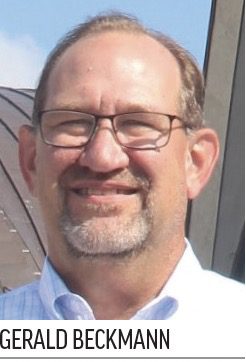The new $50 million jet fuel storage facility at St. Louis Lambert International (STL) nearly doubles the airport’s storage capacity to 3 million gallons. The fuel farm, which began operating in August, replaces an aging underground storage tank facility constructed more than 60 years ago.
The new $50 million jet fuel storage facility at St. Louis Lambert International (STL) nearly doubles the airport’s storage capacity to 3 million gallons.
The fuel farm, which began operating in August, replaces an aging underground storage tank facility constructed more than 60 years ago. The need for additional capacity and updated environmental protections prompted the modern above-ground replacement.
Construction of the 8-acre facility began in July 2019 and was completed in February 2021. The new facility includes three above-ground fuel tanks, each capable of holding 1 million gallons of jet fuel, plus room for a fourth tank if/when additional capacity is needed. The facility was constructed by STL Fuel Company LLC, a consortium of airlines operating at the airport. The consortium owns and operates the fuel farm on land leased from STL.
|
facts&figures Project: New Fuel Farm Location: St. Louis Lambert Int’l Cost: $50 million Owner/Operator: STL Fuel Company LLC, a consortium of airlines that operate at STL Storage Capacity: 3 million gallons Pumping System: 5 horizontal pumps, each capable of delivering fuel at 1,200 gallons/minute Key Features: Variable frequency drive system; automated level controls to prevent overflow; containment area; 15,000-gallon oil water separator; 3 bio-retention basins Construction: July 2019-Feb. 2021 General Contractor: Burns & McDonnell Engineering, Procurement & Construction: Burns & McDonnell Mechanical Contractor: Corrigan Co. Tank Contractor: Pittsburgh Tank & Tower Group Civil/Building Contractor: L. Keeley Construction Electrical Contractor: Schneider Electric Electrical Contractor (Transfer Line): RJP Electric System Integration: Custom Control Mfr. Inc. Fuel System Leak Detection: Hansa Consult of North America Fire Protection Specialist: Fire Tech LLC Cathodic Protection: Kadlec Associates Inc. Of Note: Consortium invested another $50 million in fuel-related infrastructure, including improvements to existing hydrant system, new emergency fuel shutoff system, hydrant cart test facility, truck load facility & new fuel dispensing stations & parking for ground service equipment |
“We had an aging system with multiple challenges,” says Airport Director Rhonda Hamm-Niebruegge. “This fuel farm has the newest technology and efficiency, allowing us to be a greener airport. It also builds on the partnership we have with our airlines to invest in the future of STL.”
Updates Needed
Replacing the fuel farm was a long time coming. The previous facility consisted of 41 underground storage tanks with a combined capacity of 1.59 million gallons. There were no visible problems, but the equipment and tanks were old and there was no built-in way to visually detect releases. Some of the equipment was installed back in 1956.
The need to address significant operational changes that had taken place over the decades was another primary catalyst for the replacement project.
“The design of the previous fueling system fit STL’s previous flight activity, which predominately operated out of one terminal,” explains Ruvim Katan, chairman of the consortium’s STL Fuel Committee. “As demand for air travel grew, the airport grew along with it, eventually expanding into Terminal 2 where Southwest Airlines is now the largest carrier.”
The fueling system, however, did not grow with the traffic. “The previous system wasn’t economical any longer, and it was time for a major refresh,” continues Katan. “Instead of investing in antiquated technology, the decision was made to invest in new technology that would make the new fuel farm system more efficient, economical, environmentally friendly and able to support St. Louis’ air travel demand for decades to come.”
Project Manager Kurt Janisch, of Burns & McDonnell, explains that the main challenge with underground tanks is identifying leakage. “If those tanks develop a leak, it will occur until you have an indication. The underground storage tank facility was built back in the 1950s, and that was prior to any environmental regulations associated with them. There was nothing built into the system that would allow for ongoing tightness testing.”
Updates Provided
The new system is vastly different, with automated level controls to prevent overflow as well as secondary containment under the tanks. “The system will send a signal out that automatically closes valves to prevent fuel from entering and overflowing the top of the tank,” Janisch explains.
Other safety measures include a containment area to capture overflow or leaks, a 15,000-gallon oil water separator to process the discharge of stormwater and three bio-retention basins to trap sediment. “There are multiple layers involved to prevent any kind of discharge of petroleum-impacted water or petroleum itself from leaving the site,” says Janisch.
 While the former fuel farm sat adjacent to the airfield, planners located a site for the new one near two petroleum product pipelines. Gerald Beckmann, STL’s deputy director of Planning and Development, notes that the consortium asked the airport to suggest a few potential sites. “Interestingly, the site chosen for the fuel farm was shown as potential passenger parking in our previous master plan,” Beckmann adds. “In this period of uncertain demand for parking, we think we have found the optimal use for the site; and it could still accommodate parking, if needed.”
While the former fuel farm sat adjacent to the airfield, planners located a site for the new one near two petroleum product pipelines. Gerald Beckmann, STL’s deputy director of Planning and Development, notes that the consortium asked the airport to suggest a few potential sites. “Interestingly, the site chosen for the fuel farm was shown as potential passenger parking in our previous master plan,” Beckmann adds. “In this period of uncertain demand for parking, we think we have found the optimal use for the site; and it could still accommodate parking, if needed.”
The distance between the fuel facility and terminal complex (almost 2 miles) necessitated an 11,000-foot underground pipeline that connects the new fuel farm to the terminal hydrant system. Installing the 16-inch diameter pipeline required careful orchestration between the contractors and several key entities.
“We encountered several challenges because we had to cross a public road and work in the aircraft movement area, which limited the use of the runways,” Janisch explains. “We had to shut down the runway and taxiways to complete that work. Not only did we have to coordinate with the airport about access to the site, but we also had to work with the FAA, which had an engineer on site at all times making sure their utilities were not damaged during construction.”
Parallel runways 12L-30R and 12R-30L both had to be shut down consecutively when workers installed part of the pipeline, but airfield traffic happened to be lighter at the time. “There aren’t too many silver linings associated with COVID, but this was one of them,” Janisch remarks. “During construction, the airport had significantly reduced usage; so that allowed them to utilize one of the parallels much of the time.”

Katan notes that new equipment increases reliability and enhances safety when it comes to fueling aircraft from the hydrant system. “The new fuel facility has five horizontal pumps, each of which is capable of delivering fuel at 1,200 gallons per minute,” he adds.
A variable-frequency drive system ensures that pumps are triggered by demand instead of using simple on and off switches. This also makes the pumps more efficient, resulting in lower energy usage and costs.
A leak-detection system from Hansa Consult of North America LLC allows testing of the main fuel line from the fuel facility to the terminals to ensure integrity of the piping. “Due to the length of this pipeline, we could run a smart pig through it to measure wall thickness,” Janisch says. “It’s expensive and won’t be done on a regular basis. But if there were ever a problem with the transfer line, we have equipment in place where we can actually perform an integrity test to determine if there is any degradation within the pipe and know where to fix it ahead of any potential leak.”
On site at the fuel farm, a 4,300-square-foot operations building includes a control room, offices and a vehicle maintenance garage. There is also a structure for storing a firefighting foam system and another for trash. The fuel farm is surrounded by perimeter fencing and monitored by security cameras.

Other Improvements
In addition to building the new $50 million fuel farm, the consortium has spent another $50 million on other fueling infrastructure improvements at STL. Nearly 1,000 feet of 16-inch carbon steel piping was installed underground between Terminals 1 and 2 in 2018 to prepare for the new fuel farm.
A major upgrade of the hydrant system was also completed for additional safety, Janisch adds. That project included installing hydrant pits and adding cathodic protection, as well as replacing transfer-site connectors and manifold equipment. “To improve the reliability of the system, airlines invested heavily to make sure the hydrant system would function and be as environmentally safe as possible,” summarizes Janisch.
Two new components of the fuel system became operational this summer. A truck load facility allows fueling operators to fill tankers and fuel aircraft not parked near the hydrant system; and two fuel dispensing stations with both gasoline and diesel fuel allow crews to keep belt loaders, tugs, tractors and other ground service equipment on the move. In addition, the emergency fuel shutoff system for the whole fuel system was replaced and upgraded.
“Fueling vehicles is where you have your highest potential for spills,” Janisch notes. “Centralizing that activity minimizes the risk.”
Beckmann says that the airline fuel consortium was key to the project’s success. “From STL’s perspective, the airlines that serve this airport were very effective in speaking with one voice through the chairperson of the fueling consortium,” he says. “This was even true during personnel changes at the airlines over the course of the multi-year project.”
Beckmann advises other airports undertaking fuel farm projects to focus on strategic site selection. “A fuel farm is likely to be there longer than most other high-expense facilities your airport maintains,” he reasons.
 As airport director, Hamm-Niebruegge acknowledges the investment that air carriers made to plan and execute the project. “Our current airline partners invested a significant amount of money at STL to bring a state-of-the-art fuel farm,” she says. “This commitment validates the strength of our partnerships, because airlines invest where they see a long-term future.”
As airport director, Hamm-Niebruegge acknowledges the investment that air carriers made to plan and execute the project. “Our current airline partners invested a significant amount of money at STL to bring a state-of-the-art fuel farm,” she says. “This commitment validates the strength of our partnerships, because airlines invest where they see a long-term future.”
Closing and decommissioning the former fuel farm is the responsibility of STL Fuel Company. That process is scheduled to begin in October.



